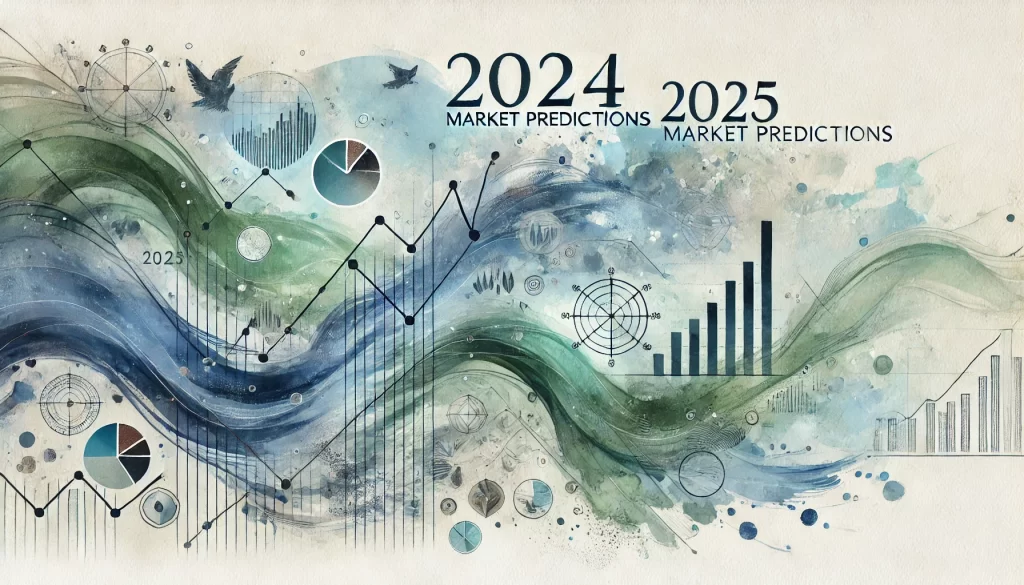
At the end of every year, big banks and financial institutions release their market predictions for the coming year. We are now seeing many predictions for what’s in store for markets in 2025. Let’s see how those predictions worked out in 2024.
In December 2023, major financial institutions provided varied forecasts for the 2024 market returns, reflecting diverse perspectives on economic conditions, monetary policies, and geopolitical factors. Here’s a comparative overview of their predictions alongside the actual market performance up to December 10, 2024:
Goldman Sachs
Goldman Sachs exhibited optimism, forecasting the S&P 500 to reach approximately 6,200 by December 2024, based on expectations of continued economic growth and supportive monetary policies.
Fundstrat
Fundstrat shared a bullish outlook, anticipating the S&P 500 could climb as high as 6,300 by year-end. He acknowledged potential near-term volatility due to economic data releases and Federal Reserve decisions but advised investors to “buy the dip,” citing factors like the “Fed put” and the “Trump put” as market stabilizers.
J.P. Morgan
J.P. Morgan adopted a more cautious stance, forecasting modest earnings growth of 2–3% for the S&P 500, with a year-end target of 4,200. The firm expressed concerns over a challenging macroeconomic environment, including slowing global growth and persistent inflation, which could weigh on equity markets.
Morningstar
Morningstar’s outlook was tempered, projecting a 10-year nominal return of 4.6% for U.S. stocks, reflecting concerns about elevated equity valuations and potential constraints on future gains. They emphasized the importance of diversification and a long-term investment approach.
Zacks Investment Research
Zacks anticipated a positive year, with the S&P 500 expected to finish up over 20% and the Nasdaq 100 reaching all-time highs with a return exceeding 50%. This optimism was driven by advancements in artificial intelligence and resilient economic indicators.
Forbes
Forbes highlighted a consensus analyst price target for the S&P 500 at 5,090, suggesting an approximate 8.5% upside from current levels at that time. They noted that while the market had momentum, valuations appeared stretched, and future gains would depend on robust earnings growth.
Vanguard
Vanguard’s December 2023 outlook anticipated a return to “sound money,” with expectations for core inflation to fall to 2.4% in 2024. They projected moderate economic growth and advised investors to maintain diversified portfolios to navigate potential market volatility.
Actual 2024 Market Performance
As of December 10, 2024, the S&P 500 has experienced significant growth, aligning with the more optimistic forecasts:
- S&P 500 Performance: The index has risen approximately 26.9% year-to-date, closing at 6,052.85 on December 9, 2024.
- Nasdaq Composite: The Nasdaq has also seen substantial gains, up 31.5% year-to-date, closing at 19,736.69 on December 9, 2024.
These robust performances have been largely driven by advancements in artificial intelligence and strong economic indicators, corroborating the more bullish predictions from institutions like Goldman Sachs and Fundstrat.
The actual market performance in 2024 has surpassed many expectations, with the S&P 500 achieving significant gains. The optimistic forecasts from institutions such as Goldman Sachs and Fundstrat have been validated, while more conservative projections underestimated the market’s resilience and growth.
This outcome underscores the inherent uncertainties in market forecasting and highlights the importance of a balanced investment strategy that considers both potential growth opportunities and risks.
As 2025 approaches, major financial institutions have released their forecasts for stock market returns, inflation, and GDP growth. Here’s a quick overview of their projections:
Stock Market Returns
- Goldman Sachs: Projects the S&P 500 to reach 6,500 by the end of 2025, indicating a 9% price gain from current levels and a total return of 10% when including dividends. This forecast is based on expectations of 5% sales growth, aligning with nominal GDP growth.
- Oppenheimer Asset Management: Anticipates the S&P 500 will climb to 7,100 by 2025, driven by efficiencies from artificial intelligence across various sectors. This target suggests a 17% increase from current levels.
- T. Rowe Price: Expects the S&P 500 to achieve approximately a 10% return in 2025, supported by moderated interest rates, fiscal stimuli, and deregulation.
Inflation
- Goldman Sachs: Forecasts core Personal Consumption Expenditures (PCE) inflation to fall to 2.1% by the end of 2025, excluding potential tariff effects.
Goldman Sachs
- Bank of America: Predicts core PCE inflation will be at 2.8% by the end of 2025, with a peak of 2.9% by the second quarter of 2026, remaining above the Federal Reserve’s 2% target.
- SIFMA Economist Roundtable: Estimates core PCE inflation to decrease to 2.4% in 2025, influenced by factors such as wage growth and domestic demand.
GDP Growth
- Goldman Sachs: Expects the U.S. economy to outperform expectations, with real GDP growth of 2.5% in 2025, supported by a significant decline in inflation over the past two years.
- Bank of America: Projects stable GDP growth, reaching 2.5% in the first quarter and averaging 2.3% throughout 2025, aided by strengthening productivity and potential fiscal policy easing.
- SIFMA Economist Roundtable: Forecasts real GDP growth at 1.9% for 2025, slightly lower than previous estimates, with considerations of wage growth and monetary policy impacts.
Final Thoughts
The consensus among major financial institutions suggests a positive outlook for 2025, with anticipated stock market gains, controlled inflation, and steady GDP growth. However, projections vary, reflecting differing views on economic conditions, policy impacts, and market dynamics. Investors are advised to consider these forecasts in the context of their individual investment strategies and risk tolerance.
The variation in predictions, as well as the deviation in actual market performance, shows that nobody knows what will happen in the future. We believe in efficient markets, which essentially means that information is priced into stock valuations as soon as it becomes available.
The things that affect the market the most are things that cannot be foreseen, such as natural disasters, pandemics, wars, and surprise bankruptcies. Diversification ensures you have exposure to areas of the market that are going up and limits your exposure to areas of the market that are going down. With about a week left in the year and a market that seems to be cooling, we will soon see how close these estimates are to actual year end returns.
Contact us at 49thparallelwealthmanagement.com to discuss your portfolio or other areas of your financial plan. From the Desert to the Tundra, we are your cross-border retirement experts!




